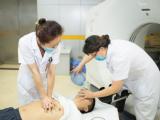Apr 10, 2003 (CIDRAP News) – In response to public concern, the Centers for Disease Control and Prevention (CDC) will provide some guidelines for dealing with suspected cases of severe acute respiratory syndrome (SARS) in schools and workplaces, CDC Director Julie Gerberding said today.
"Later today you'll see guidance for schools and workplaces," Gerberding said at an afternoon news briefing. In making the comment, she referred to reports that a 6-year-old boy in Florida attended school while having possible SARS symptoms. News reports said the boy, who attends school in Niceville, Fla., apparently caught the illness from a relative who recently traveled to Singapore. The boy reportedly is now recovering from the illness at home.
Gerberding said CDC will provide guidelines for managing cases in which people with suspected SARS go to school or work. So far, she said, CDC has not seen any SARS cases in the community, separate from cases involving people who recently traveled to Asia or their close contacts.
Nor has CDC seen any evidence that asymptomatic people can transmit the SARS agent—believed to be a previously unknown coronavirus—or that the virus can spread through blood or feces, Gerberding said.
A new report in the New England Journal of Medicine says that genetic material from the coronavirus suspected as the cause of SARS was found in patients' plasma and feces. Viral RNA was found in "extremely low concentrations" in plasma during the acute phase of the illness and in feces during the convalescent phase, according to the report by a group of European investigators. The report was released online today.
"We have no evidence at the moment that this is in any way a bloodborne infection, but we have to be concerned about at least a temporary period of time when the virus could be in the blood," Gerberding said. She added that CDC is working to develop some "sensible guidance" for protecting the blood supply. Later, she emphasized that there is "absolutely no evidence of a problem with the blood supply," adding, "We're not initiating look-back investigations at this point in time" because there's no indication of a need for that.
Gerberding also said there is "no direct or indirect evidence" that fecal material is playing a role in transmission of SARS. "Finding PCR [polymerase chain reaction] evidence of the virus in stool may mean the virus is in the stool, or it may mean that genetic material from the virus is in the stool—two very different possibilities," she said.
In other comments, Gerberding said important hurdles remain before the new coronavirus is confirmed as the cause of SARS and before diagnostic tests for the virus can be widely distributed.
To prove that the virus is the SARS pathogen, "First, we need to unequivocally demonstrate the coronavirus in affected tissue, ie, the lung, of infected patients" who also have evidence of pneumonia, she said. Second, the virus must be shown to cause illness in an animal and then be recovered from the animal, a task that investigators in the Netherlands are working on, she said.
Gerberding predicted that CDC will be ready to distribute SARS diagnostic tests to state health laboratories in about 2 weeks. Before then, she said, the agency must perfect the methodology so that test results are highly consistent, make a sufficient supply of the reagents for the tests, develop techniques that work for every kind of equipment that might be used, and send blind samples to laboratory personnel so they can try out the tests.
On another SARS topic, Gerberding said CDC is concerned about some reports of "stigmatization" of Asians in connection with SARS. "It's important that people appreciate that this is a respiratory illness caused by a virus . . . but it's not a disease that's in any way related to being Asian," she said. CDC has established an outreach team to work with community groups to provide factual information and combat any ethnic biases related to SARS, she added.
CDC is also creating a 2-minute video about SARS to be shown on international airline flights, Gerberding reported. The purpose is to inform passengers what they do and don't need to be concerned about.
See also:
New England Journal of Medicine article: Identification of a novel coronavirus in patients with severe acute respiratory syndrome (Drosten C, et al)
http://content.nejm.org/cgi/content/full/348/20/1967



















